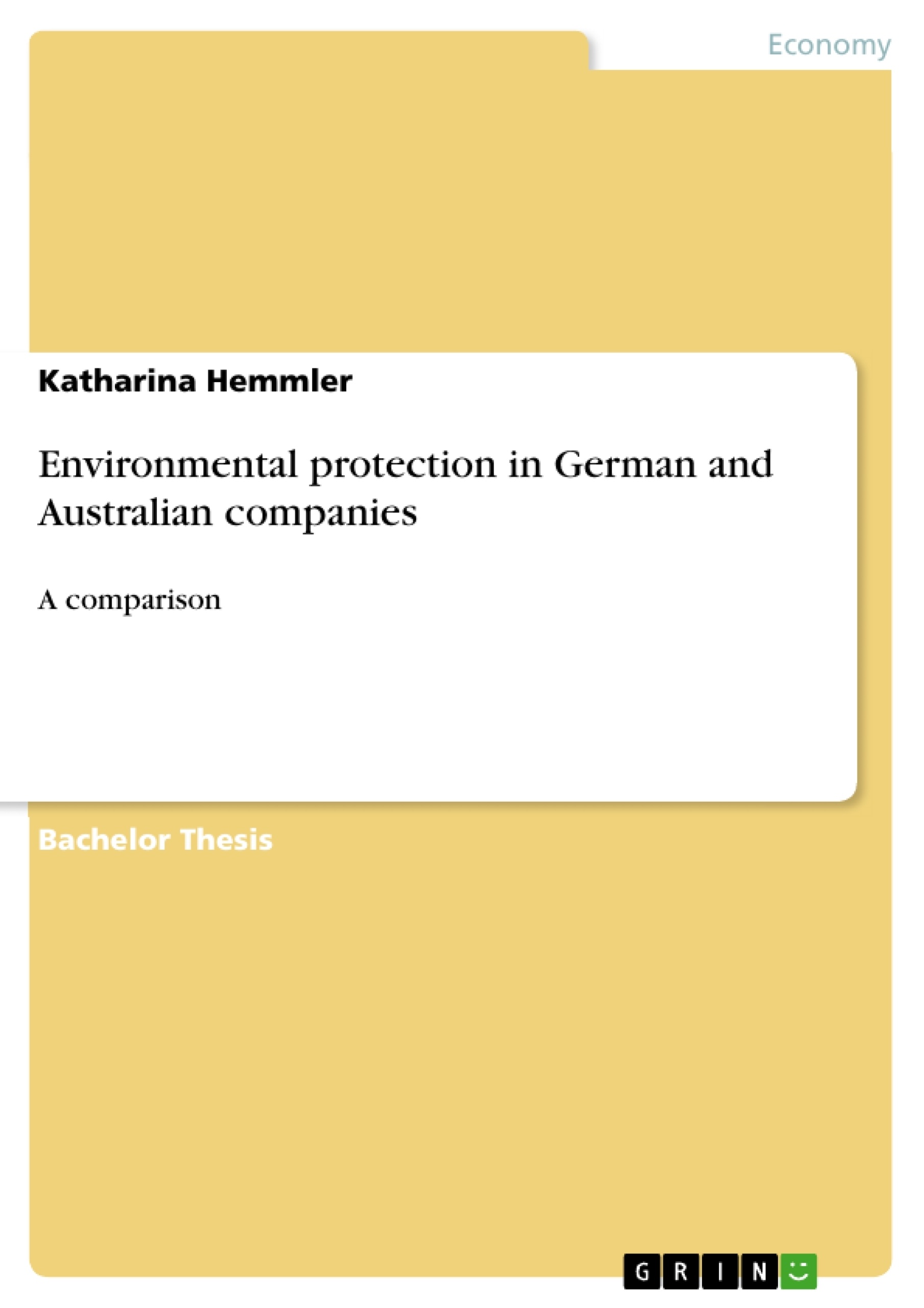This paper deals with the role of environmental protection in companies. The focus is on the combination of theoretical considerations of environmental management and the practical application of a survey. The theoretical part lays the foundation and presents a comprehensive elaboration of motivations, obstacles and tools of corporate environmental protection. Furthermore, particular attention will be drawn to the concept of Green Supply Chain Management. The aim of the survey of German and Australian companies is to elaborate the implementation of environmental protection measures and to reflect current views of the economy on environmental protection.
Diese Arbeit befasst sich mit der Rolle des Umweltschutzes in Unternehmungen. Die Kombination von theoretischen Überlegungen des Umweltmanagements mit der praktischen Anwendung einer Umfrage steht im Fokus. Der Theorieteil legt die Grundlagen und bietet eine umfangreiche Ausarbeitung der Gründe, Hindernisse und Werkzeuge des betrieblichen Umweltschutzes. Außerdem wird besonders auf das Konzept des Green Supply Chain Managements eingegangen. Ziel der Umfrage, gerichtet an deutsche und australische Unternehmen, ist sowohl die Ausarbeitung der Umsetzung von Umweltschutzmaßnahmen als auch das Widerspiegeln eines aktuellen Meinungsbilder der Wirtschaft zum Umweltschutz.
Inhaltsverzeichnis (Table of Contents)
- Introduction
- Theoretical Background
- Definitions
- Origins of the mismatch
- The most severe environmental concerns
- Pollution
- Climate Change
- Loss of biodiversity
- Ozone layer depletion
- Toxins
- Dying oceans
- Waste and littering
- Natural Resource Depletion
- Deforestation
- The IPAT Equation
- Environmental economists on the rise
- The role of trade agreements and globalisation
- Drivers for corporate environmental protection
- Green stakeholders
- Government regulators
- Green Consumers
- Ethical Investors
- Employees
- Environmental interest groups
- Lenders and Insurers
- Environmental standard setters
- Benefits of going green
- Cost savings
- Product differentiation
- Improved public image
- Other benefits
- Summary
- Green stakeholders
- Obstacles to corporate environmental management
- No need
- No resources
- High costs
- Greenwashing
- SMES
- Environmental Management Tools
- Environmental Management Systems
- Which requirements must be met?
- How can an EMS be developed?
- ISO 14000 certification
- Life cycle analysis
- Environmental auditing
- Environmental reporting
- Environmental Impact Assessment
- Change management and conclusion
- Environmental Management Systems
- Green Supply Chain Management
- Introduction
- Eco-design
- Green procurement
- Green manufacturing
- Green distribution
- Green packaging
- Green Logistics Management
- Reverse logistics
- End-of-life management
- Product Stewardship
- Extended producer responsibility
- Summary
- Survey evaluation
- Methodology
- Purpose of the study
- Definition of the target group
- Type of survey
- Survey generation
- Power up
- Distribution
- Processing answers
- Analysing data
- Results and analysis
- Company details
- The most severe environmental problems
- Drivers and obstacles of corporate environmental protection
- Environmental standards
- Production processes and green supply chain management
- Solutions
- Conclusion and Recommendation
- Methodology
- Summary and conclusion
Zielsetzung und Themenschwerpunkte (Objectives and Key Themes)
This paper explores the role of environmental protection within companies. It combines theoretical aspects of environmental management with practical data from a survey. The paper examines the motivations, challenges, and tools of corporate environmental protection, with a particular focus on Green Supply Chain Management. The survey, conducted among German and Australian companies, aims to investigate the implementation of environmental protection measures and reflect the current business perspective on environmental protection.
- Environmental Protection in Companies
- Theoretical Framework of Environmental Management
- Green Supply Chain Management
- Implementation of Environmental Protection Measures
- Business Perspectives on Environmental Protection
Zusammenfassung der Kapitel (Chapter Summaries)
- Introduction: This chapter sets the stage for the paper, introducing the topic of environmental protection in businesses and highlighting the importance of integrating theoretical and practical perspectives.
- Theoretical Background: This chapter provides a comprehensive foundation for understanding the principles of environmental management, covering definitions, historical context, and the most pressing environmental challenges.
- Drivers for Corporate Environmental Protection: This chapter explores the various factors motivating companies to adopt environmentally responsible practices, including green stakeholders, such as government regulators, consumers, investors, and employees, as well as the potential benefits of going green, such as cost savings, product differentiation, and improved public image.
- Obstacles to Corporate Environmental Management: This chapter examines the challenges faced by companies in implementing environmental management systems, including factors such as lack of perceived need, resource constraints, high costs, and the potential for greenwashing.
- Environmental Management Tools: This chapter delves into the specific tools and strategies available to companies for managing their environmental impact, including Environmental Management Systems (EMS), life cycle analysis, environmental auditing, reporting, and impact assessments.
- Green Supply Chain Management: This chapter focuses on a critical aspect of environmental management, exploring the concept of Green Supply Chain Management and its key components, including eco-design, green procurement, green manufacturing, green distribution, end-of-life management, and product stewardship.
- Survey Evaluation: This chapter presents the methodology and results of a survey conducted among German and Australian companies to assess their environmental practices, motivations, and challenges. The chapter analyzes data related to company details, environmental problems, drivers and obstacles of environmental protection, environmental standards, production processes, and solutions.
Schlüsselwörter (Keywords)
The primary keywords and themes of this paper include environmental management, externalities, resources, green stakeholders, SMEs, environmental impact, environmental standards, reverse logistics, and product stewardship. The paper explores both theoretical aspects of environmental management and practical applications of these concepts in the context of business practices.
- Quote paper
- Katharina Hemmler (Author), 2017, Environmental protection in German and Australian companies, Munich, GRIN Verlag, https://www.grin.com/document/368990



